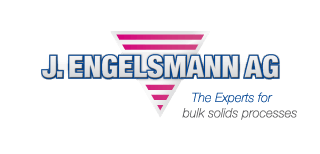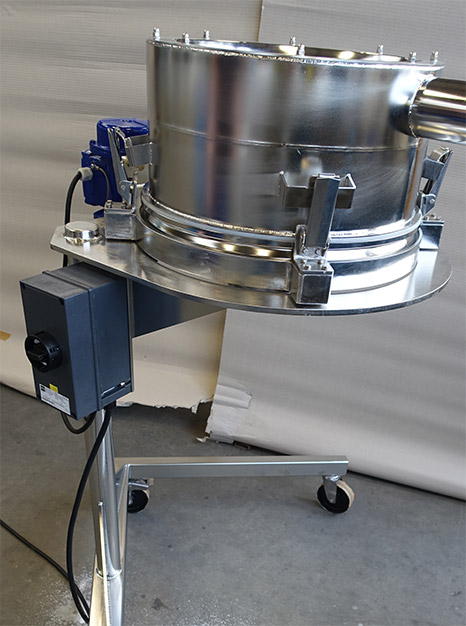15.12.2016
Quality assurance in pharmacological production:Quickly separate the coarse from the fine
The regulations for producing pharmaceuticals are extraordinarily high. The highest possible protection for the users is primarily guaranteed by aspects of hygiene which, in the form of the GMP regulations, should ensure the highest possible product quality when manufacturing pharmaceuticals. When processing precursors in particular, a flawless quality is important. For this reason, the smallest contaminations need to be removed before processing the products into capsules or tablets. An upstream protective screening doesn’t just provide the necessary product quality, it also reduces the quality costs, as a current project by the screening machine manufacturer J. Engelsmann AG shows.
As well as having a germ free production environment which must meet the highest hygiene requirements, the precursor needs to be free of agglomerates, oversized particles and dust before being processed further to ensure precise dosages and the highest level of purity possible in the agents formed into capsules or tablets. Upstream protective screening of the precursor undertakes this task. Adjusting the screening technology necessary for this to the hygiene regulation, the existing production conditions and how easy the product is to screen all need to be considered when implementing a machine solution as the following example of use shows:
A globally active pharmaceutical company was looking for a new production line in its factory in Turkey, a machine solution for the protective screening of a precursor which had previously not been processed at that location. At the Turkish factory, pharmaceuticals were being made for various areas of application.
Upstream protective screening ensures the desired product quality
The powdered precursor has a particle size of between 80 and 200µm and partially contains some larger particles. The dry and pourable precursor raises dust easily and is prone to electrical charge. It is to be pressed into tablets after being protectively screened as selectively as possible. Here, the unwanted agglomerates, adherent dust particles as well as the particles which are larger than the particle range determined are filtered out.
It was important to the pharmaceutical manufacturer that the smallest possible and economical machine was used for the protective screening. It needed to be easily transportable to a special wash room to be cleaned and meet all hygiene related GMP directives. They wanted to keep the existing processing process and not make any big changes so that the machine could be integrated as seamlessly as possible into the production process.
Since the pharmaceutical manufacturer already has successfully employed a protective screening machine for a similar precursor, their Turkish colleagues were advised to request a solution from the Ludwigshafen based screening machine manufacturer J. Engelsmann AG. After their first meeting to determine the task and the exact requirements, it was agreed that the Turkish factory was to receive the same machine model for testing purposes. After several tests using the new precursor they were very happy with the screening results. The only problem that needed to be solved was that of dust formation during the sieving process which consequently affected the surroundings. Since the precursor screened in the German factory didn’t produce dust, this problem was first noticed as part of the test phases with the original product.
The machine used for the trial was a vibration screening machine from the JEL Fix range and was specially designed by Engelsmann for protective screening. Thanks to its low construction height (277.5mm) and the lower space requirements the protective screening machine is particularly suited for use in narrow space constraints e.g. integration into existing facilities or processes in production.
Machines employed in pharmacology lower machine downtimes
The vibration machine is constructed modularly and enables different uses that can be flexibly tailored to the customer’s needs. So in this case a machine lid is eschewed so that one of the existing driers upstream of the protective screening can feed the precursor directly onto the screening material of the protective screening machine using the metering canal included in delivery. In the inlet area of the channel which forms the U trough, there is a height adjustable feed funnel. The channel is completely built on a magnetic momentum drive. The dosage of the product stream is regulated by a thyristor control unit which can sensitively be regulated from a trickle of particles up to a strong product stream. The particles are moved on the sieve using a vibration motor which is fixed to the side of the round body of the machine. In protective screening, two fractions are filtered: The material, i.e. the product in the desired particle range that is channeled through the outflow of the screening machine and out to a tablet press downstream and the oversized particles which exceed the desired particle range. The oversized particles, such as agglomerate, stay on the screen mesh and are removed from the machine through an installed oversized particle outflow. Because of dust formation an exhaust is built underneath the screen mesh by special design. The rim of the sheet with a surrounding gap is connected with an exhaust connector by way of which a filter device already on site extracts the dust particles. Since the machine is cleaned regularly in line with the hygiene regulations and it must be transported from the site to a special wash room, the JEL Fix was fitted with a mobile base frame and completely earthed in case of the product becoming electrically charged. The pushed in screen ring can be changed in just a few steps and the machine can be washed quickly and easily thanks to direct access, this minimizes the machine downtime. According to the GMP directives, only the 80kg, 1.20-meter-high vibration screening with smooth and electrolytically polished surfaces as well as sealants conforming to FDA regulations is up to pharmaceutical standards and was implemented in the production area as ATEX version.








